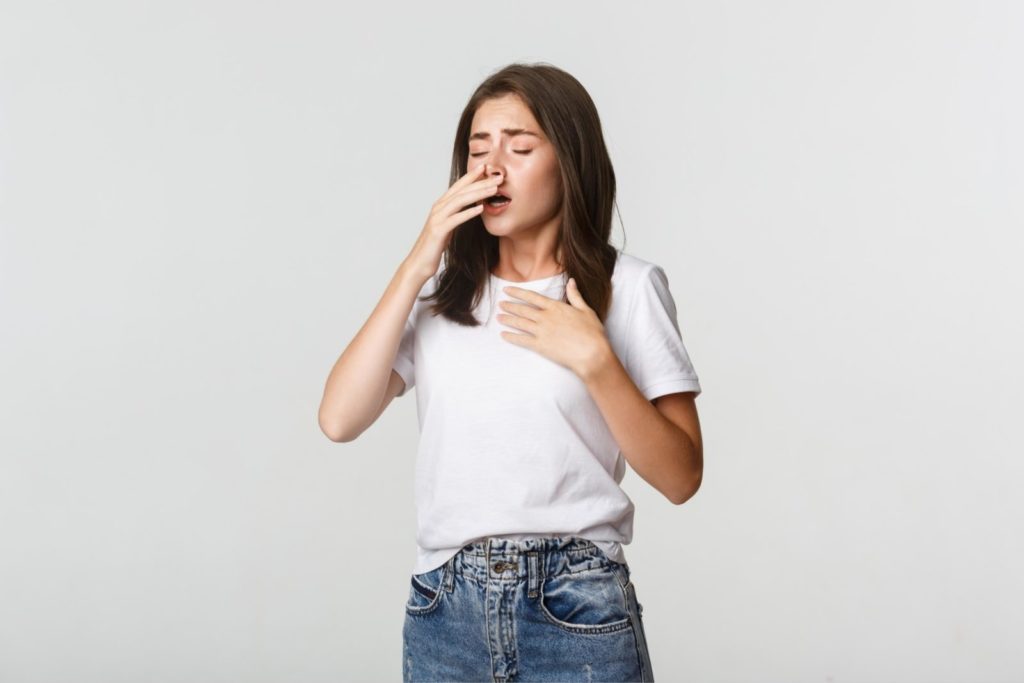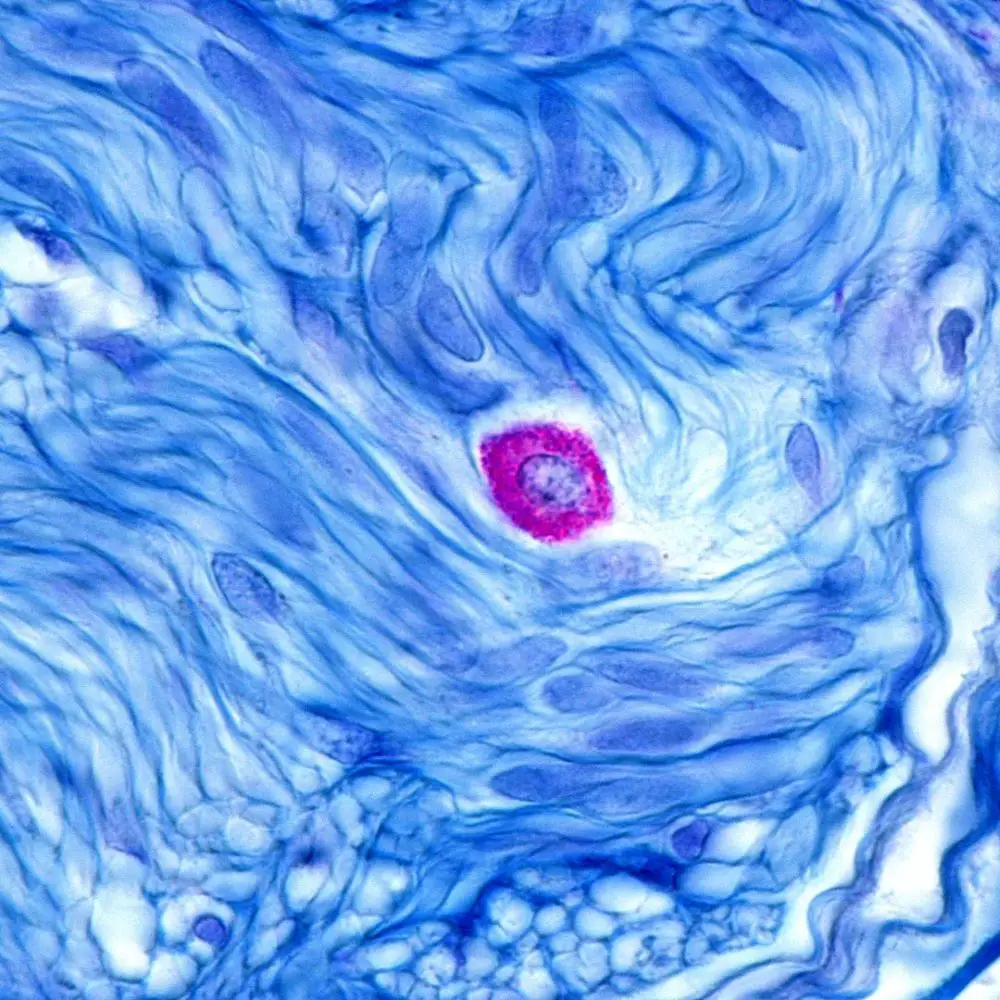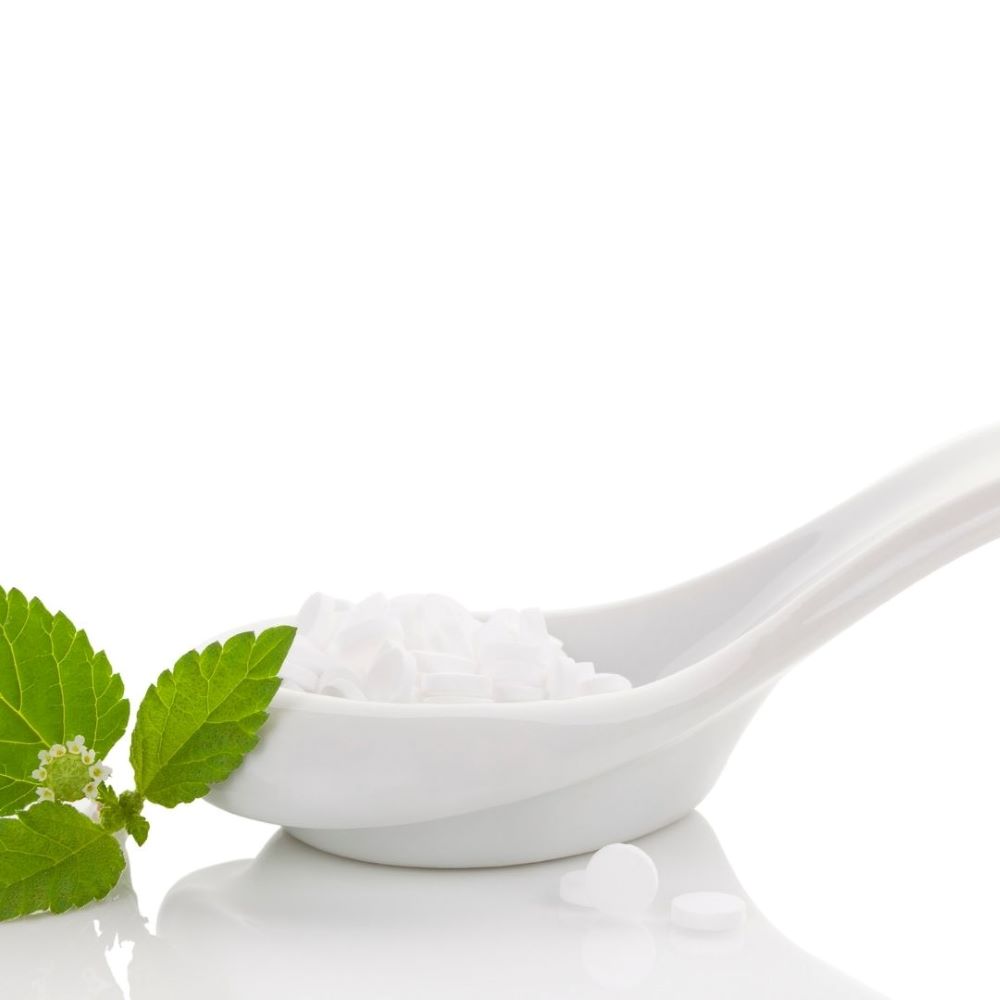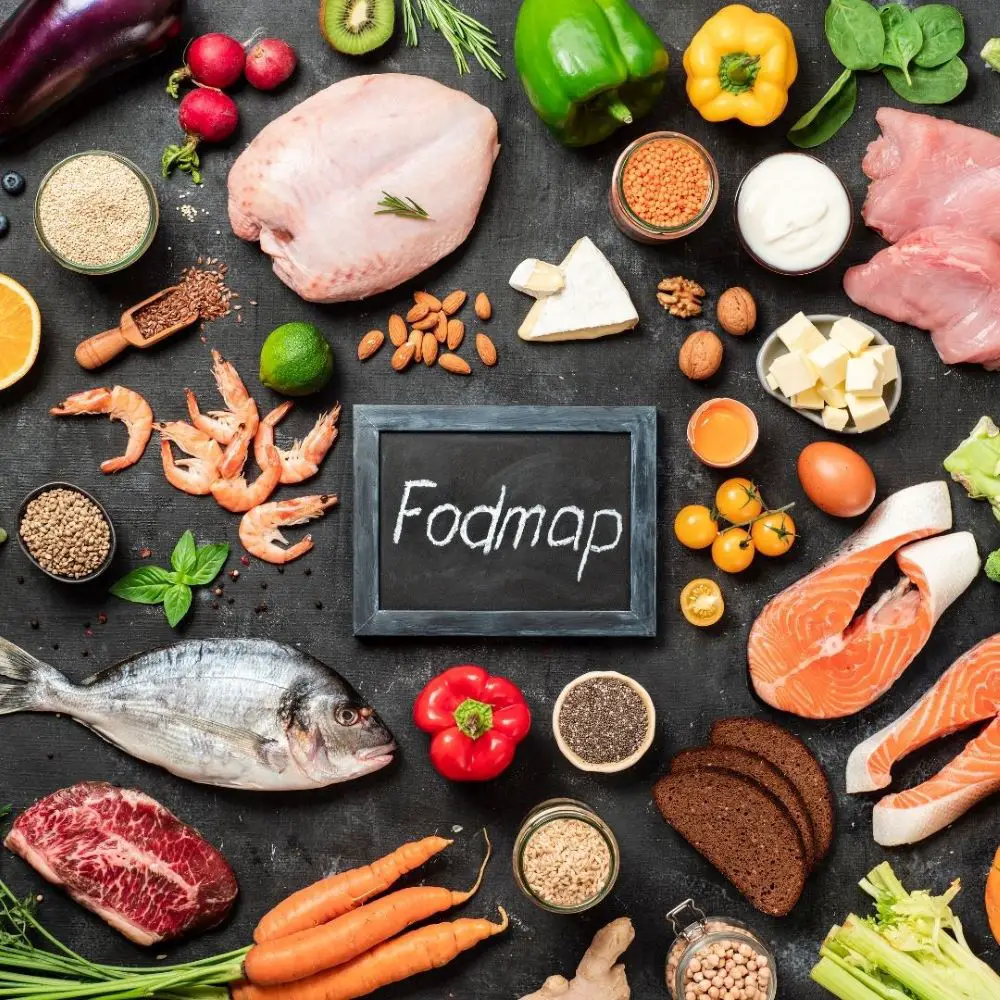What role does a low FODMAP diet play in histamine intolerance? If you have histamine intolerance, also known as histamine sensitivity, the goal is to reduce the amount of histamine in your body. In turn, that helps reduce your symptoms.
With histamine sensitivity or intolerance, your body is sensitive to foods that contain histamine and foods that stimulate histamine release. Your body’s histamine burden is too high, since you can’t break down the histamine fast enough, and it builds up to levels that cause symptoms. (1)
The approach to treating histamine intolerance is to remove foods from your diet that cause histamine release or increase histamine overload. Many people do well with a low-histamine diet. But there’s also evidence that some people with histamine intolerance benefit from a low FODMAP diet too.

Should You Adopt a Low-FODMAP Diet with Histamine Sensitivity?
First things first. If you’re diagnosed with histamine intolerance, the first step is to eliminate foods that contain histamine or stimulate histamine release.
Because you can’t break histamine down as efficiently as someone without this condition, your histamine tank gets too full when you eat foods that increase your body’s histamine burden.
There isn’t a reliable test for diagnosing histamine intolerance. (2) So, the diagnosis is based on symptom improvement in response to dietary changes.
By following a low-histamine diet and reducing histamine-releasing foods in your diet, you should notice an improvement in your symptoms because you’re reducing your body’s histamine burden.
If you don’t feel your symptoms are improving, question whether some other factor contributes to your symptoms. Could it be sensitivity to FODMAPs?

Are FODMAPs Making Your Histamine Intolerance Worse?
Eating a low-histamine diet is an effective strategy for taming histamine intolerance, but some people with histamine intolerance also benefit from eating a low FODMAP diet.
FODMAP stands for fermentable oligosaccharides, disaccharides, monosaccharides and polyols. These are short-chain carbohydrates that the intestinal tract doesn’t absorb well. Instead, bacteria ferment these carbohydrates and produce gases. So, it’s not surprising that they cause gas and bloating for some people.
The low-FODMAP diet may be familiar if you have irritable bowel syndrome (IBS) or know someone who does. Doctors also tell people with inflammatory bowel disease, like Crohn’s or ulcerative colitis, to reduce FODMAPs, since they can worsen their intestinal symptoms. (6)
A subset of people who adopt a low FOD-MAP diet experience improvement in their IBS symptoms. (4) But you might also give low FODMAP a trial if you have histamine intolerance.
Studies suggest that some people with histamine intolerance experience fewer symptoms of histamine overload when they adopt a low-FODMAP diet.
A study carried out in 2016 found that when people with irritable bowel syndrome adopted a low FODMAP diet, their digestive symptoms improved, and their histamine levels dropped by eightfold. (3)
Not Everyone with Histamine Sensitivity Improves on a Low-FODMAP Diet
Not everyone with histamine intolerance will improve on a low FODMAP diet, but there is a subgroup of people who will. If you have a history of irritable bowel syndrome currently or in the past, there is even more reason to eliminate FODMAPs.
But it’s also worth a try if you have persistent symptoms on a low-histamine diet and aren’t getting the symptom relief you expect. You may discover added symptom improvement by eliminating FODMAPs.
Is there science to back this up? A study found that a low FODMAP diet lowered the amount of histamine released into the urine, while eating a high FODMAP diet increased the concentration of histamine in the urine. (5)
*
One theory is that the breakdown products of FODMAPs activate mast cells, cells that produce histamine. Less histamine reduces your body’s histamine tank and helps you experience fewer symptoms.
As mentioned, FODMAP breakdown products may cause mast cells to release more histamine. But there’s another theory too. Since high FODMAP foods contain lots of fiber, consuming a low-FODMAP diet may reduce the amount of “food” that histamine-producing gut bacteria can use to reproduce and flourish.
Humans can’t easily break down fiber and use it for energy, but bacteria can. They depend on fiber to provide energy and help them survive.
When you eat many FODMAP foods, you help these histamine bacteria thrive and reproduce, and that leads to more histamine production. When you eliminate these foods, the histamine-producing bacteria are at a disadvantage, and there will be fewer of them around to cause symptoms. This is one theory, but it’s unclear how eliminating FODMAPs lowers histamine, but there’s evidence that it does.
A Trial of a Low FODMAP Diet May Be Beneficial if Diarrhea is One of Your Symptoms
One clue you may respond to a low-FODMAP diet is if you have diarrhea as a component of your histamine intolerance symptoms. But keep in mind that persistent diarrhea can be a sign that something else medically is going on. Don’t assume your diarrhea comes from histamine intolerance. See your doctor to rule out other causes first.
Beyond irritable bowel syndrome, a low FODMAP diet also helps people with other functional digestive disorders. Eliminating or reducing FODMAPs helps reduce gas and bloating in people susceptible to them.

Although there’s not enough evidence to say that everyone with histamine intolerance responds to a low-FODMAP diet, you won’t know unless you give it a test run.
If you’re doing well on a low histamine diet, there’s no reason to eliminate all FODMAPs from your diet. FODMAPs are abundant in many healthy foods. Plus, a low-histamine diet also removes many healthy foods from your diet.
It’s challenging to follow a low FODMAP and low-histamine diet simultaneously. But if you have digestive symptoms that aren’t responding as well as expected to a low-histamine diet, eliminating FODMAPs for a few weeks as a test may be helpful.
Breaking Down the Components of a Low-FODMAP Diet
As mentioned, FODMAPs are indigestible carbohydrates and include fermentable oligo-, di-, and mono-saccharides and polyols. Let’s look at each component and what foods you find them in.
The following are the indigestible carbohydrates that may cause problems for some people with irritable bowel syndrome, inflammatory bowel disease, or histamine intolerance.

Oligosaccharides
These are chains of 3 to 10 simple sugar molecules linked together. Examples of foods high in oligosaccharides include:
- Onions and garlic
- Wheat and rye
- Lentils and beans of all types
- Agave syrup, used as a natural sweetener
- Sugar alcohols, like erythritol, maltitol, and xylitol. These are in some sugar-free and low-sugar products.
- Chicory root
- Jerusalem artichokes
- Asparagus
- Jicama
- Disaccharides
- These are made of two sugar molecules linked together to form a unit, and include:
- Table sugar
- Dairy products
- Sugar beets

Monosaccharides
Monosaccharides are composed of a single sugar molecule. These include foods high in glucose and fructose. Many fruits contain glucose or fructose, including:
- Apples
- Watermelon
- Grapes
- Mango
- Papaya
- Cantaloupe
- Blueberries

Polyols
Polyols are sugar alcohols and include maltitol, sorbitol, xylitol, mannitol, and erythritol. They’re in:
- Some low-carb and sugar-free candies and diabetic products
- Some sweeteners
- Fruits with pits, like peaches
- Some vegetables, like cauliflower
Most problematic polyols are in low-carb products and sweeteners, since they have higher concentrations than fruits and vegetables.
Many people without irritable bowel or histamine intolerance experience digestive symptoms when they eat sugar alcohols, especially sorbitol and maltitol.
Erythritol and xylitol are less likely to cause digestive symptoms, but it depends on how much you consume.
Most people have a tolerance level for polyols. They may be fine with a small amount, but develop symptoms when they go over a certain threshold.
FODMAP Sensitivity May Vary with the FODMAP
Some people who are sensitive to FODMAPs develop symptoms with all FODMAPs, but it’s more common to be sensitive to some, but not all, FODMAPs. For example, consuming foods high in polyols might aggravate your symptoms, while oligosaccharides do not.
How to Test a Low-FODMAP Diet for Histamine Intolerance
You can find various sites that list foods to avoid on a low-FODMAP diet. Here’s a link to one. Here’s the sequence:
- Eliminate all foods on the list of high FODMAP foods for 3 weeks.
- Gradually add foods on the list back while monitoring your symptoms.
- Identify foods that cause symptoms and eliminate them from your diet.
This is akin to the elimination and rechallenge diet that people sometimes do for histamine intolerance. It can show you what you can tolerate without developing and what you can’t.
An elimination diet is one of the best ways to identify food intolerances of all kinds. Many dietitians recommend it to patients with food intolerances, so they can identify which trigger symptoms.

Keep a journal of your symptoms throughout the elimination and rechallenge phases of the diet. Without taking this step, you won’t know what foods are problematic.
Even people who are sensitive to FODMAPS can often tolerate some FODMAP foods in small quantities. It takes experimentation to determine which ones cause problems and which don’t.
You should only stay on an elimination diet long enough to identify what triggers your symptoms. There’s no point in eliminating healthy foods from your diet that don’t cause issues, and doing so can lead to nutritional deficiencies.
An elimination diet isn’t something to follow long-term. It’s a way to get the insights you need to make smarter dietary decisions, and you’ll feel less in the dark about why you’re having digestive symptoms, despite being on a low-histamine diet.
If Your Symptoms Get Better on a Low-FODMAP Diet
If your symptoms improve significantly when you go low-FODMAP, you might be tempted to keep FODMAPs entirely out of your diet. The drawback is that a low-FODMAP diet is restrictive and eliminates many nutrient-dense foods if you stay on it long term.
Plus, from a convenience and pleasure standpoint, it’s tough to follow a diet low in histamine and FODMAPs for a lengthy period of time.
If you have to restrict your diet, because both FODMAP and histamine foods worsen your symptoms, consult a nutritionist or dietitian who can help you put together a diet ’s nutritious and balanced, but won’t aggravate your symptoms.

A dietitian can help structure a diet plan that contains the nutrients you need without making your histamine sensitivity worse.
If you have to restrict many foods in your diet, you may also need vitamin or mineral supplements. That’s something to talk to your doctor or dietitian about. Make sure you select as many nutrient-dense foods as possible, and get as much variety as possible, while staying symptom free, to prevent nutritional deficiencies.
For good health, eating a wider variety of healthier foods helps you best meet your body’s nutritional needs. Make sure you eliminate only those foods that cause problems, based on the results of an elimination diet.
Don’t Self-Diagnose
Too often, people assume they have a certain condition based on what they read, but they don’t have a firm diagnosis.
One danger of doing an elimination diet and self-diagnosing based on the results is that you may have another reason for your symptoms, and it gets missed. If you have persistent symptoms after adopting a low-FODMAP diet, let your doctor know.
The same applies to the diagnosis of histamine intolerance. It’s critical that you rule out other causes for your symptoms, before assuming it’s histamine intolerance, and changing your diet accordingly.
If you don’t respond to a low-histamine lifestyle, it’s a red flag that something else may be going on, and you need to know about it. Don’t ignore it.
The Bottom Line
Some people with histamine intolerance experience continued digestive symptoms even after switching to a low-histamine diet. That’s when you might consider eliminating FODMAPs and keeping a symptom journal.
As you add foods back into your diet, you’ll get a better idea of which might trigger your symptoms, so you can eliminate them. Finding which foods worsen your symptoms can be a tedious and frustrating process, but hang in there! It will be well worth it. Now, find out whether probiotics are high in histamine.
References
- Journal of the Academy of Nutrition and Dietetics. Is There a Diet for Histamine Intolerance? Jill Balla Kohn, MS, RDN, LDN. DOI:https://doi.org/10.1016/j.jand.2014.09.009
- Reese I, Ballmer-Weber B, Beyer K, et al. German guideline for the management of adverse reactions to ingested histamine: Guideline of the German Society for Allergology and Clinical Immunology (DGAKI), the German Society for Pediatric Allergology and Environmental Medicine (GPA), the German Association of Allergologists (AeDA), and the Swiss Society for Allergology and Immunology (SGAI). Allergo J Int. 2017;26(2):72-79. doi:10.1007/s40629-017-0011-5. https://pubmed.ncbi.nlm.nih.gov/28344921/
- “An Update On Histamine Intolerance and IBS – Amy Burkhart ….” https://theceliacmd.com/histamine-intolerance-and-ibs/.
- Magge S, Lembo A. Low-FODMAP Diet for Treatment of Irritable Bowel Syndrome. Gastroenterol Hepatol (N Y). 2012;8(11):739-745. https://www.ncbi.nlm.nih.gov/pmc/articles/PMC3966170/
- McIntosh K, Reed DE, Schneider T, Dang F, Keshteli AH, De Palma G, Madsen K, Bercik P, Vanner S. FODMAPs alter symptoms and the metabolome of patients with IBS: a randomised controlled trial. Gut. 2017 Jul;66(7):1241-1251. doi: 10.1136/gutjnl-2015-311339. Epub 2016 Mar 14. Erratum in: Gut. 2019 Jul;68(7):1342. PMID: 26976734.
- National Institute of Diabetes and Digestive and Kidney Diseases. Eating, Diet, & Nutrition for Irritable Bowel Syndrome. https://www.niddk.nih.gov/health-information/digestive-diseases/irritable-bowel-syndrome/eating-diet-nutrition

